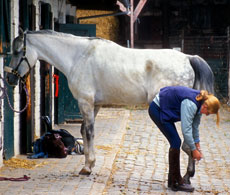
How to Poultice a Horse Hoof
Veterinary surgeon Lucy Grieve explains how poultices work, when you should apply one and the steps to follow
If your horse is exhibiting lameness and one hoof is warmer to the touch than the others, it could be due to a foot abscess, which occurs when foreign matter and bacteria get into the hoof and cause infection. This infection can enter the living tissues of the foot, so it’s vital that you call your vet straight away for advice.
If the abscess isn’t likely to erupt by itself, your vet will probably make a small hole to establish drainage, allowing fluid and pus to seep away from the abscess. Once that has been done, you can poultice the foot yourself as part of the treatment process.
Why use a poultice?
A poultice is used to draw out infection and keep the area clean to prevent further reinfection. Modern poultice dressings (such as Animalintex) contain boric acid and tragacanth, which work as an antiseptic and help draw out the pus.
Some people debate hot and cold poultices – personally, I don’t think it matters which is used, and sometimes it’s not practical to get hot water. The key question is whether to use a wet or dry poultice.
A wet poultice (the most common way to apply) is more effective at drawing fluid to out, but a dry poultice could work well if an abscess has a lot of fluid coming out on its own.
Step-by-step guide for applying a poultice
- Make sure the foot is clean and dry. Apply a piece of poultice material that has been cut to the size of the affected area – don’t poultice more of the foot than you have to, as the hoof can become waterlogged and this weakens the horn.
- If you’re using a wet poultice, wet the material using clean, boiled water that has cooled enough so you can handle it, then squeeze out the excess fluid and apply to the foot.
- Wrap a layer of soft padding (such as Gamgee, Soffban bandage or even a baby’s nappy) over the top of the poultice and around the foot, paying particular attention to cushioning soft tissue areas such as the heel bulbs and the coronary band.
- Apply Vet Wrap or any other conforming bandage over the top that will stick to itself and hold the dressing on. (A conforming bandage is a medical dressing designed to mould itself to the shape of the area it’s applied to.) As long as you have enough padding underneath, you can apply decent pressure here. You don’t want it too tight as this can cause pressure over the soft tissues, but not too loose either as it will fall off.
- Place Elastoplast and then duct tape over the top to create a waterproof layer. (An old intravenous drip bag, which you may be able to get from your local vet, can be a good waterproof and protective material to put over the top. You can also use a poultice boot, but be careful it doesn’t rub. Other good options include thick plastic haylage bags or feed sacks to keep moisture and dirt out).
- Change the poultice at least once a day, or more if there’s a lot of pus coming out.
- Only use a wet poultice for two to three days at a time, then switch to a dry poultice or dressing to keep the area clean. Providing that your vet has opened up the hole effectively, it should drain in that time – if you leave a wet poultice any longer the wound and hoof will get waterlogged, which may weaken the foot.
- Watch out for any swelling coming up the pastern, as this can be a sign that the infection is going up the leg. If this happens, call your vet immediately.
- Remember, if you’re unsure at any point, ask your vet to show you how to poultice a foot or for more advice generally on how to help your horse’s foot heal.



